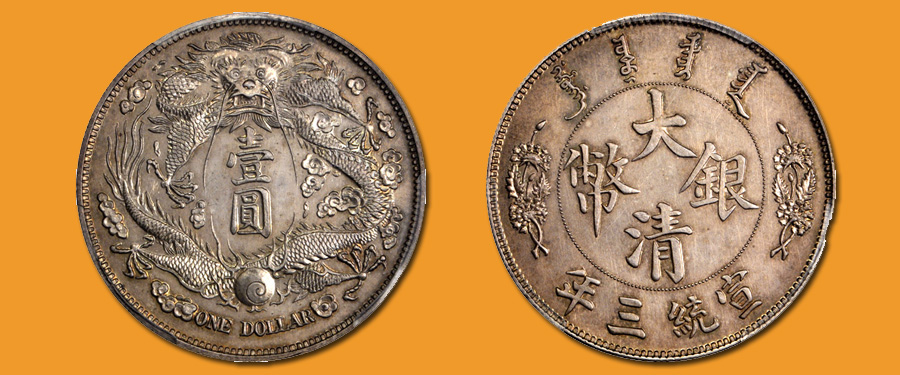
Struck in silver, this is the rare first variation of the "dragon in clouds" style with smaller more robust characters and blunt floral leaves. This type is referred to as the "ordinary obverse" as the characters resemble the later adopted standard design 1911 Empire Dollar. The Central Mint in Tientsin – operated by the Board of Revenue in Peking – was set to produce a standard currency system that would circulate throughout China, and replace the multiple provincial mints producing coinage. Unfortunately, China’s administrative disorganization (as well as a lack of sufficient funds) inhibited the reforms from gaining traction. The provincial Viceroys who stood to lose wealth and influence fought these reforms for years. Despite this resistance, the Imperial Government attempted coinage reform multiple times, with the final attempt occurring mere months before the final collapse of the Imperial Regime to the Revolution of 1911.
The design for this new coinage would share many elements with preceding Imperial and provincial coinage but would have many simplified elements meant to impart the message of continued Imperial authority throughout China. This was an important message as the reigning Emperor Hsuan Tung was only six years old at the time. This new coinage would bear an Imperial dragon (with five toes on each foot) much like its provincial forbears, but this dragon would dominate the entire face of the coin. The dragon glares out from 12 o’clock, its body wrapping and twisting throughout the periphery of the coin while in the center is the denomination of one Yuan essentially encircled and protected by the symbol of the Emperor. The inscription and legends also send a stripped down message of Qing sovereignty.
The reverse design contains the Chinese and Manchu legends expressing all of the necessary information for the piece. Between the outer crenulated border and the inner pearled ring the Manchu and Chinese characters form the outer legend. Four Manchu characters appear above, and four Chinese characters below which state: “Hsuen Tung, 3rd Year” (1911), and these sets of characters are separated by ornate floral sprays. This example contains raised veins on leaves closest to the central inscription. The central Chinese legend states: “Ta Ch’ing Yin Pi” meaning: Great Ch’ing (Dynasty) Silver Coin.
Once this initial design had been completed it went through several refinements before it was finalized. The first modification was a slight tweaking of the calligraphy in the legends and inscription along with a redesign of some of the floral sprays flanking them. Next the dragon’s whiskers were shortened so they no longer surround the denomination at center, Kann also mentions seeing a transitional design in which the dragon bears medium length whiskers but this was never struck in any significant quantity. The final stages of design are more familiar to most collectors as the “Flying Dragon” dollars which share the same composition as the earlier models but the dragon has been refined with a smaller head, short wavy feelers and more realistically rendered clouds about it. This final design was struck in great quantity at the Tientsin and Wuchang mints, however the uprising of 1911 in the latter city forced this new design to enter circulation as emergency military pay. Even after the establishment of the Republic of China this dragon coinage was still struck as an appropriate design, as a new Republic dollar could not be made quickly enough, and hence the dragon dollars were struck up until the introduction of the Yuan Shih-kai dollars in 1914.
This example is beautifully struck with rich detail throughout on a planchet of very lustrous metal. Deep golden-amber toning enhances the contrast between the devices and the surrounding fields. This coin holds the distinction for being the finest certified example for this variety of Long Whisker Dragon Pattern Dollar, tied with one example of a different variety at PCGS and one example at NGC.
Look for this and other Asian and world numismatic rarities in our upcoming Rarities Night Auction on May 20th, the day after the inaugural D. Brent Pogue Collection Part 1 on May 19th. Preview this impressive coin along with the rest of our auction this April at the Stack’s Bowers and Ponterio office located in Irvine, California. For details please refer to the Events Calendar link at www.StacksBowers.com. To schedule an appointment, please call 800.458.4646. While our Stack’s Bowers Galleries Rarities Night Auction on May 20th is no longer open for consignments, we are currently taking consignments of ancient and world coins for our August 2015 ANA World’s Fair of Money Showcase Auction and Asian coins and currency for our August 2015 Hong Kong Showcase Auction. Time is running short, so if you are interested in consigning your coins and paper currency (whether a whole collection or a single rarity) be sure to contact one of our consignment directors.





